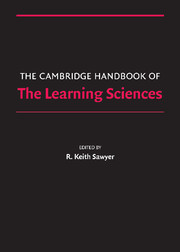Book contents
- Frontmatter
- Contents
- Preface
- Contributors
- 1 Introduction
- PART I FOUNDATIONS
- 2 Foundations and Opportunities for an Interdisciplinary Science of Learning
- 3 Constructionism
- 4 Cognitive Apprenticeship
- 5 Cognitive Tutors
- 6 Learning in Activity
- 7 Knowledge Building
- PART II METHODOLOGIES
- PART III THE NATURE OF KNOWLEDGE
- PART IV MAKING KNOWLEDGE VISIBLE
- PART V LEARNING TOGETHER
- PART VI LEARNING ENVIRONMENTS
- Afterword: After How Comes What
- Epilogue: The Fundamental Issue in the Learning Sciences
- Author Index
- Subject Index
- References
6 - Learning in Activity
Published online by Cambridge University Press: 05 June 2012
- Frontmatter
- Contents
- Preface
- Contributors
- 1 Introduction
- PART I FOUNDATIONS
- 2 Foundations and Opportunities for an Interdisciplinary Science of Learning
- 3 Constructionism
- 4 Cognitive Apprenticeship
- 5 Cognitive Tutors
- 6 Learning in Activity
- 7 Knowledge Building
- PART II METHODOLOGIES
- PART III THE NATURE OF KNOWLEDGE
- PART IV MAKING KNOWLEDGE VISIBLE
- PART V LEARNING TOGETHER
- PART VI LEARNING ENVIRONMENTS
- Afterword: After How Comes What
- Epilogue: The Fundamental Issue in the Learning Sciences
- Author Index
- Subject Index
- References
Summary
This chapter discusses a program of research in the learning sciences that I call “situative.” The defining characteristic of a situative approach is that instead of focusing on individual learners, the main focus of analysis is on activity systems: complex social organizations containing learners, teachers, curriculum materials, software tools, and the physical environment. Over the decades, many psychologists have advocated a study of these larger systems (Dewey, 1896, 1929/1958; Lewin, 1935, 1946/1997; Mead, 1934; Vygotsky, 1987), although they remained outside the mainstream of psychology, which instead focused on individuals. Situative analyses include hypotheses about principles of coordination that support communication and reasoning in activity systems, including construction of meaning and understanding.
Other terms for the perspective I refer to as situative include sociocultural psychology (Cole, 1996; Rogoff, 1995), activity theory (Engeström, 1993; 1999), distributed cognition (Hutchins, 1995a), and ecological psychology (Gibson, 1979; Reed, 1996). I use the term “situative” because I was introduced to the perspective by scholars who referred to their perspective as situated action (Suchman, 1985), situated cognition (Lave, 1988), or situated learning (Lave & Wenger, 1991). I prefer the term “situative,” a modifier of “perspective,” “analysis,” or “theory,” to “situated,” used to modify “action,” “cognition,” or “learning,” because the latter adjective invites a misconception: that some instances of action, cognition, or learning are situated and others are not. During the 1980s and 1990s these scholars and others provided analyses in which concepts of cognition and learning are relocated at the level of activity systems.
- Type
- Chapter
- Information
- The Cambridge Handbook of the Learning Sciences , pp. 79 - 96Publisher: Cambridge University PressPrint publication year: 2005
References
- 27
- Cited by



